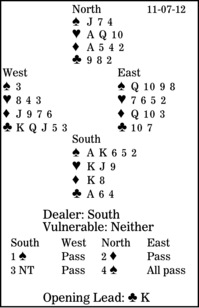Bridge column, November 7: The two losers turn into one

We have a concertina play in bridge. How does it apply in this deal? South is in four spades. West leads the club king. How should the play proceed?
If you employ the Losing Trick Count, you will know that the North hand is a bit weak for a game-invitational limit raise. However, with 11 high-card points and two aces, he was right to upgrade. Then, after South showed a balanced hand with 18, 19 or a poor 20 points, North might have passed, but he continued with his bidding plan.
Declarer could see several losers: two in clubs and zero, one, two or three in spades. He had eight top tricks: two spades, three hearts, two diamonds and one club.
Shrugging his shoulders, South took the first trick and cashed his top trumps, learning that he had two spade losers -- and apparently four in all. But rather than give in, declarer set out to take 10 tricks. He cashed his diamond king (the honor from the shorter side first), played a diamond to dummy's ace, and ruffed a diamond in his hand. Then he took his three heart tricks, ending in the dummy.
That was nine tricks in and South called for another diamond. He and East each had two spades left, so East could not stop declarer from scoring one more trump trick.
What happened to declarer's fourth loser? At trick 13, West had a winning club and East had a top trump, which were concertinaed into a single winner.
** ** **
COPYRIGHT: 2012, UNITED FEATURE SYNDICATE
DISTRIBUTED BY UNIVERSAL UCLICK FOR UFS

